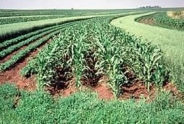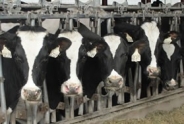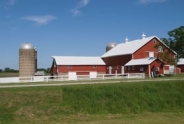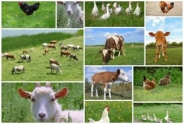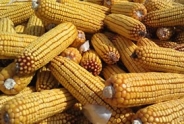Identifying Risk is the First Step to Managing It
Katelyn Walley, Business Management Specialist and Team Leader
Southwest New York Dairy, Livestock and Field Crops Program
This article was written by Mary Kate Wheeler, Farm Business Management Specialist with the South Central NY Dairy and Field Crops Team and originally appeared on their blog.
Most of us live in a culture that values comfort and control. Modern technologies give us the ability to meet our basic needs and modify our environments from the convenience of our living rooms. We use smartphones and virtual assistants to access food, shelter, transportation, even social interaction. From ordering groceries, to booking a vacation, to adjusting the thermostat, an app exists for everything. Consumers embrace this technology because it provides a sense of security, convenience, and control.
Agricultural producers, on the other hand, exist in a world of uncertainty. Uncertainty means not knowing what will happen in the future, and making decisions when the future outcomes of those decisions are unknown. Farmers face uncertainty related to weather, crop and livestock performance, input and output prices, cash flow, access to capital, consumer demand, legal liability, family and business relationships, and more. While adoption of modern technologies may help producers reduce some types of uncertainty, farmers do not have the luxury of ignoring it.
Uncertainty implies risk, which means there is a possibility of failure. Yet while uncertainty creates the potential for loss, it may also create the potential for gain. In the words of Extension Risk Management Education's Introduction to Risk Management, "Risk is what makes it possible to make a profit. If there was no risk, there would be no return to the ability to successfully manage it." Not only is risk unavoidable in agriculture, but managing it well is an essential function of any farm operation.
For agricultural producers and consumers alike, the coronavirus pandemic has provided a stark reminder that none of us has complete control over the many forces that influence our lives. Despite experiencing rapid change and profound uncertainty, farms continue to operate as essential businesses. In uncertain times, producers can benefit from an organized approach to managing risk. This process begins with identifying and categorizing different types of uncertainty that farms face. This article describes five types of risk that affect farm businesses, and illustrates each category with examples from the COVID-19 context.
Production Risk
When you manage an agricultural business, you develop a production system to achieve a desired yield. Depending on your enterprise, you may measure yields in tons or bushels per acre, pounds of gain per day, or pounds of milk per cow. Regardless of the production system, any variation in production outcomes has an impact on the farm's financial bottom line. Production risk encompasses the chance of poor yields, low quality products, or other unfavorable outcomes from production activities.
Farm yields fluctuate over time in response to numerous conditions, some of which are easier to manage than others. Variable weather, including impacts of climate change, is perhaps the most obvious source of production risk. We consider pests and diseases to be major production risks for crop and livestock enterprises.
Variation in input quality, such as forage quality on a dairy farm, is also a source of production risk. The COVID-19 outbreak has threatened to disrupt supply chains in many industries, including agriculture. As a result, some farms may be experiencing greater uncertainty about the availability and quality of production inputs, compared to previous years.
What are the most significant production risks on your farm? How have they changed since COVID-19?
Marketing Risk
In economic terms, a market is both a system that facilitates the exchange of goods and services between buyers and sellers, and a process through which prices are established. Any event that impacts the behavior of buyers or sellers has the potential to affect markets and prices. When farmers face uncertainty around prices or market access, it is called marketing risk.
With the closure of schools and restaurants, the spike in unemployment, and the adoption of social isolation practices, the coronavirus pandemic has affected U.S. consumers and producers in numerous unexpected ways. Market prices for agricultural inputs and outputs responded quickly to these changes, with some prices rising and others falling. For example, the sudden drop in export and food service demand contributed to a 20% decline in the USDA all-milk price from March to April 2020. Over the same period, the average consumer price for eggs climbed 15%, while consumer prices for poultry and beef increased by 4.7% and 4.2%, respectively.
Whether or not an individual farm experiences negative impacts of the pandemic depends greatly on how it markets its products. Farms selling directly to restaurants, or to wholesale channels supplying the food service industry, may have lost expected revenues and market access because of COVID-19. On the other hand, farms that sell directly to consumers, particularly through channels that allow for social distancing, may have benefitted from higher product prices and sales volumes.
What marketing risks affect your farm business? Do you have greater uncertainty about input or output prices? How secure is your access to markets, and what conditions might make it less secure?
Financial Risk
Most businesses rely on outside capital to grow and sustain operations. Financial risk refers to uncertainty about the cost and availability of capital and other financial resources necessary to operate a business. This category includes uncertainty around interest rates, a lender's willingness to put money into your business, the market value of your collateral, and your ability to meet cash flow needs. All of these considerations influence a farm's capacity to overcome short-term financial shocks and grow equity in the long term.
The economic impacts of the coronavirus pandemic may increase uncertainty around cash flows and access to capital for farm businesses. Farms that experience an unexpected drop in product prices or sales will immediately face greater uncertainty about their ability to meet short-term cash obligations. Some farms may be able to defer principal payments as a way to improve cash flows, but how long will the lender support that strategy?
Some farms businesses may need greater access to capital to overcome the short-term shock of COVID-19. At the same time, the economic contraction accompanying the coronavirus pandemic may make lenders more cautious. One of the five C's that agricultural lenders use to evaluate creditworthiness is "condition," which refers to the overall state of the industry and the broader economic environment. As the economy enters a recession, and the agricultural sector faces processing bottlenecks and changes in consumer demand, lenders may be more conservative about extending credit to agricultural businesses.
What is your farm's exposure to financial risk? How has COVID-19 affected your farm's cash flows and access to capital?
Legal Risk
In the course of their normal activities, farm business regularly make commitments that have legal implications. Legal risk refers to the possibility of unfavorable consequences stemming from contractual arrangements, organizational structure, laws and regulations, tort liability, and public relations. For example, a farm's failure to comply with food safety or labor regulations could increase its exposure to legal risk. The ownership structure of a farm business has legal consequences that span tax liability, tort liability, and business succession. Public perception influences a farm's social license to operate in the short run, and may shape public policy to be more or less favorable to agriculture in the long run.
The arrival of COVID-19 introduced new uncertainties about a farm's legal obligations and liabilities. What obligations does a farm business have to protect its employees and customers from COVID-19? What are the implications of compliance, or non-compliance, with new social distancing regulations? Uncertainties about the government's COVID-19 policy response also falls into this category.
What legal risks affect your farm business? Is regulatory compliance a concern for your farm? What about public perception and neighbor relations?
Human Risk
We all know that people can sometimes be unpredictable. In a farm business, people are not only a source of risk, they are also a key resource for managing it. Human risk encompasses uncertainty related to human health and wellbeing, family and business relationships, employee management, and business transitions. The ultimate goal of human risk management is the safety, productivity, and satisfaction of everyone who participates in the business.
The coronavirus pandemic has elevated concerns about the risk of human illness, since a COVID-19 outbreak on a farm has the potential to severely disrupt labor and management. To mitigate the health risks, farms have adopt new policies and procedures around social distancing, cleaning, and sanitation. However, by reducing in-person interactions, some of these policies may make team communications and employee management more challenging. Strong leadership and communication skills can help farm managers to maintain key business and family relationships while adapting to change.
What are the most significant human risks on your farm? How has COVID-19 affected relationships among key people involved in the farm?
Resources
For more about identifying and managing risk, check out the Introduction to Risk Management handbook compiled by Extension Risk Management Education and the USDA Risk Management Agency.
This is material is based upon work supported by USDA/NIFA under Award Number 2018-70027-28588.
Upcoming Events
WNY Pastureland Conversion & Soil Health Field Day
July 16, 2025
Middleport, NY
Join American Farmland Trust for the Western New York Soil Health Field Day on July 16, 2025, at Zeliff Farm in Middleport, NY, from 9:00 AM-3:15 PM. Learn about pasture conversion, soil health benchmarking, biochar in grazing systems, and best grazing practices. Plus, enjoy hands-on demos with the NY Soil Health Trailer, drones, and cover crops! Check out the attached agenda for more information about the field day and REGISTER HERE. Zeliff Farms is a regenerative beef operation who has recently partnered with AFT on outreach and education to farmers including learning circles and evaluating biochar effects on soil health.
IPM Strategies to Protect Corn and Soybean Seed in NY
July 30, 2025
Hamburg , NY
SWNYDLFC and Cornell IPM are hosting a grower meeting to discuss integrated pest management strategies for protecting corn and soybean seed in New York.
FAMACHA Training for Sheep and Goat producers in Woodhull NY
August 13, 2025 : FAMACHA Training in Woodhull
Woodhull, NY
Join us for a discussion and hands-on training for internal parasite integrated pest management in sheep and goats. Certification is available to all students participating in the workshop.
Announcements
No announcements at this time.

